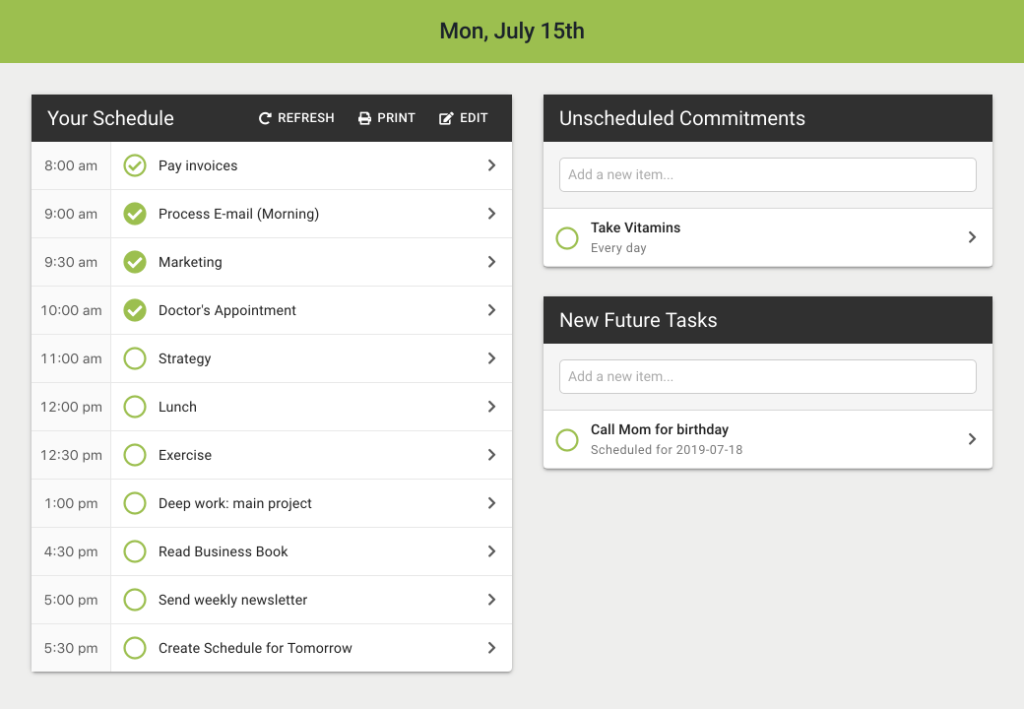Do you maintain a task list where you check things off as you go throughout your day?
What if I told you there are things you’re leaving off the list?
Things that are so common, you don’t even think about them. You don’t even realize how they eat time from your day and can make you miss some of your goals. All because you’re just not paying attention to them.
Today I’m going to teach you how to identify them and account for them when planning your day.
Are you ready to level up your planning game?
Daily activities—the missing ingredient
We often spend time on things each day that don’t show up on our task list—things that are so common we don’t even think about them.
But if we don’t account for these things and the time they take out of our day, we’ll think we have way more time in our day than we actually do.
The result: we get over-ambitious about our task list and get stressed when we can’t get it all done.
So, what is the missing ingredient to our task list? Daily activities.
What is an “activity”?
Simply put, activities are things you do on a regular basis that are never “done”.
They range from things like taking breaks, eating meals or doing your morning routine, to spending time on marketing efforts for your business or even habits like working out.
For instance, I bet you eat lunch each day. But do you put “Lunch” on your to-do list? Do you account for the time it takes to eat lunch when you are planning your day? If not, you have 30-60 fewer minutes available in your day to do work.
And usually it’s not just lunch…it’s all the maintenance and renewal activities we need to keep our bodies and our businesses healthy. These can easily add up to 1-2 hours each day that we’re not accounting for on our to-do list.
Creating a more realistic day
To make sure you are mentally accounting for the time it takes to do all of these activities in your day, create an Activity List. Download this worksheet to help.
Write down every thing you do on a regular basis that is not tracked on your task list. Next to that, write the frequency of the activity. Is it every day? Once a week? Only on certain days of the week?
Add activities to this list to have a realistic representation of what your day looks like. Otherwise, exercising and having lunch will eat time out of your day. pun intended
Now that you have this list, review it each day as you are planning what to work on each day. Recognize the time these activities are taking out of your day, and use that understanding to plan fewer, more important tasks into your day, while maintaining the activities that support you and your business.
How does an activity differ from a task?
Are you confused exactly how an activity differs from a task?
While they are similar, there are 3 key differences. For instance, let’s take lunch. It’s:
- Never Done
You never stop eating lunch. Even if you mark it off your list, it’s not completed forever, but only for the day. - Never Overdue
If you miss lunch one day, you don’t need to eat two lunches tomorrow. Activities don’t pile up. - Always a Fresh Start
Whether you do an activity today or not doesn’t affect tomorrow. Each day is a fresh start to do the activity or skip it.
While they seem similar, activities operate different than tasks. If you plan your day on paper, it’s easy enough to copy them each day from your master activity list to your daily plan.
Unfortunately, most task managers are not equipped to handle activities, showing them as overdue or forcing you to check off activities from previous days before checking off the activity for today.
That’s why I recommend creating a separate activity list to review each day and bring awareness of the time required by these into your consciousness—unless, of course, you are using Day Optimizer, which has both Activities and Tasks that can be added into your daily plan, so you always know exactly how much time you have available in your day.
Key Takeaway
If there’s one thing I want you to remember, it’s this:
You have less time in your day than you think.
To gain awareness of how much time you really have in your day, you need to create an activity list. An activity list shows you the items that take up time in your day that aren’t on your task list, thus limiting your time optimism.
Does this potentially translate to having fewer tasks on your daily task list?
That’s good. That means you are gaining a better grasp of your time and learning to create a more realistic daily plan. Be consistent in your approach and reap the rewards. Make an activity list today.








